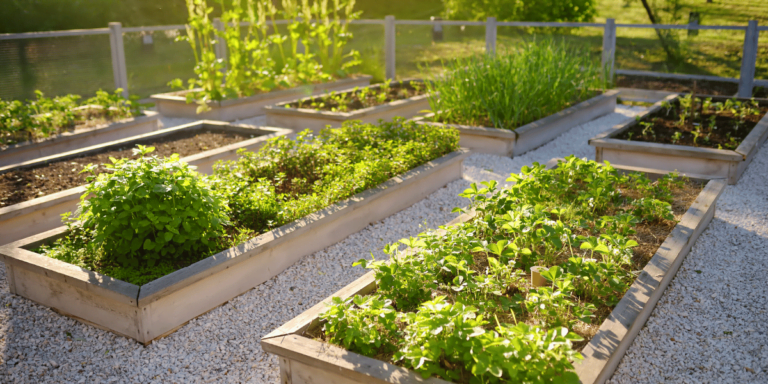Welcome to the world of sensory gardens concepts, where nature’s beauty invites you to explore and engage with your senses. A sensory garden is a remarkable outdoor space designed to captivate and delight your sight, hearing, smell, touch, and even taste. By integrating various elements, from lush plants to soothing sounds, these gardens offer a sensory journey that connects you to the wonders of the natural world.
Key Takeaways:
- Sensory gardens concepts are designed to engage all five senses – sight, hearing, smell, touch, and taste.
- Creating a sensory garden concepts involves considering factors such as dense planting, limited color palettes, and selecting fragrant plants.
- Designing a sensory garden requires attention to detail, including immersive plant choices and creating a separation from the outside world.
- Adding audio elements like wind movement, birdsong, and water features can enhance the sensory experience.
- Selecting fragrant plants and placing them strategically can create a pleasing scent throughout the garden.
- Including textured plants and tactile zones can provide a diverse and engaging experience for touch.
- Integrating edible crops allows for exploration and tasting different flavors within the sensory garden.
Creating a World Apart: Designing Your Sensory Garden
When it comes to designing a sensory garden, one of the key objectives is to create a space that feels separate and immersive, allowing visitors to disconnect from the outside world and fully engage their senses. Achieving this requires careful consideration of various elements, such as sensory garden design, dense planting, plant choices, and visual effects.
Designing an Immersive Space
In order to create a sense of separation, it’s important to focus on dense planting and layering. By incorporating dense and lush vegetation, particularly around the garden’s boundaries, you can effectively create a private and enclosed environment that offers a sense of seclusion and tranquility.
In addition to dense planting, thoughtful plant choices play a significant role in designing an immersive sensory garden. Selecting plant species that blur the boundaries between different areas and creating an interplay of colors and textures can further enhance the overall feel and mood of the space.
Consider the visual effects you want to create in your sensory garden. Do you want a calming ambiance or an energizing atmosphere? The plant choices you make can contribute to these visual effects. For example, vibrant and contrasting colors can create a dynamic and stimulating environment, while a limited color palette promotes a more harmonious and soothing atmosphere.
To better understand how plant choices and visual effects can shape the design of a sensory garden, take a look at the following table:
| Plant Choices | Visual Effects |
|---|---|
| Diverse mix of colorful flowers | Energizing and vibrant |
| Monochromatic palette with different shades of green | Calming and serene |
| Dramatic foliage plants | Bold and striking |
Note: The above table demonstrates the relationship between different plant choices and the visual effects they create in a sensory garden.
By carefully considering the design elements discussed above, you can create a sensory garden that provides a truly immersive and captivating experience for all who venture into its lush and vibrant embrace.
Creating a Soundscape: Adding Audio Elements to Your Sensory Garden
A sensory garden is not just about visual stimulation; it also encompasses the auditory senses, creating a complete sensory experience. By incorporating various audio elements, you can enhance the ambiance and create a harmonious soundscape within your garden.
Wind Movement and Rustling Leaves
The gentle movement of the wind through the trees and plants creates a soothing background noise of rustling leaves. This natural sound adds a sense of tranquility and serenity to your sensory garden. Consider planting species that sway gracefully in the breeze, such as ornamental grasses or delicate flowering plants with soft foliage.
Birdsong and Buzzing Insects
The melodic tunes of birds singing and the gentle buzzing of insects bring life and vitality to your sensory garden. Their natural sounds create a symphony of nature, immersing you in the peaceful tranquility of the outdoors. To attract birds, incorporate bird feeders, birdhouses, and native plant species that provide food and shelter for these feathered friends.
Water Features for a Calming Mood
Water features are not only visually appealing but also contribute to the auditory experience of your sensory garden. The sound of flowing water, whether it’s from a pond, fountain, or a small brook, can create a calming and serene atmosphere. The gentle gushing or trickling sounds can help mask background noises and promote relaxation.
Complementing Natural Sounds
Enhance the natural sounds of your sensory garden by incorporating wind chimes and rain chains. The tinkling and melodious sounds produced by these decorative elements add a touch of enchantment to your outdoor space. Place them strategically throughout the garden, allowing them to catch the wind and create gentle music.
You can achieve a sensory garden soundscape that immerses you in the beauty of nature. By integrating wind movement, birdsong, water features, and complementary audio elements, your garden will come alive with soothing and captivating sounds.
| Audio Elements | Description |
|---|---|
| Wind Movement | The rustling of leaves as the wind moves through the trees and plants. |
| Birdsong | The melodious tunes of birds singing in the garden. |
| Buzzing Insects | The gentle buzzing and humming of bees, butterflies, and other insects. |
| Water Features | The soothing sounds of flowing water from fountains, ponds, or brooks. |
| Wind Chimes | The delicate music created by wind chimes swaying in the breeze. |
| Rain Chains | The rhythmic sound of rainwater cascading down decorative chains. |
Engaging the Sense of Smell: Choosing Fragrant Plants for Your Sensory Garden Concepts

When creating a sensory garden, one of the key elements to consider is fragrance. The sense of smell can have a powerful impact on our emotions and overall experience in a garden. By strategically selecting and placing fragrant plants, you can enhance the sensory journey for yourself and your guests.
To create a fragrant sensory garden, start by choosing plants with pleasing scents. Here are some excellent choices:
- Lavender: Known for its calming scent, lavender is a popular choice for sensory gardens. It attracts pollinators and adds a touch of purple beauty to the landscape.
- Roses: With their timeless beauty and wide variety of scents, roses are a classic choice for a fragrant sensory garden. Opt for varieties known for their strong fragrance, such as hybrid teas and floribundas.
- Lilacs: The intoxicating scent of lilacs is a well-loved favorite. These spring-blooming shrubs fill the air with their sweet fragrance, creating a nostalgic atmosphere.
- Jasmine: With its heady, romantic scent, jasmine adds a touch of luxury to any sensory garden. Consider planting it near seating areas or entrances where its fragrance can be enjoyed.
- Aromatic Herbs: Incorporating herbs with pleasant aromas, such as thyme and rosemary, not only adds fragrance but also provides opportunities for culinary exploration.
Remember to consider the climate and specific location when selecting fragrant plants for your sensory garden. Some plants have specific temperature and sunlight requirements, so it’s important to choose varieties that will thrive in your region.
In order to maximize the impact of fragrance in your sensory garden, place the most fragrant plants closest to your home and seating areas. This way, you and your guests can fully immerse yourselves in the delightful scents while enjoying your outdoor space.
Creating a sensory garden that engages the sense of smell with carefully selected fragrant plants is a delightful way to enhance your outdoor experience. The captivating scents will transport you to a state of relaxation and connection with nature.
Tactile Experiences: Creating Textured Zones in Your Sensory Garden Concepts

Tactile experiences are often overlooked in a garden, but they can greatly enhance the sensory experience. By incorporating a variety of plant textures, you can create a diverse and engaging environment that stimulates the sense of touch. Here are some ideas to help you create textured zones in your sensory garden:
Grasses
Grasses are a fantastic addition to any sensory garden as they provide a unique texture. Consider planting ornamental grasses such as feather reed grass, switchgrass, or blue fescue. These grasses not only offer visual appeal with their graceful movement but also provide a tactile experience when brushing against their soft blades.
Tree Bark
Another way to introduce texture into your garden is through the use of different tree barks. Choose trees with interesting bark patterns, such as birch, sycamore, or paperbark maple. Running your fingers along their rough or smooth surfaces can create a sensory delight.
Lamb’s Ears
Lamb’s ears, scientifically known as Stachys byzantina, are herbaceous perennials that offer a unique tactile experience. Their soft and fuzzy leaves are reminiscent of the texture of a lamb’s ear. These plants not only add visual interest to your garden but also invite visitors to touch and interact with their velvety foliage.
Tactile Zones
Creating tactile zones in your sensory garden can further encourage engagement with nature. Consider dedicating specific pathways or sections of your garden to textured plants. Line these areas with different varieties of grasses, tree bark, and lamb’s ears to create a multi-sensory experience.
Edible Crops
Adding edible crops to your sensory garden not only provides a tasty treat but also introduces another level of tactile experience. Imagine plucking a ripe strawberry or running your hands through a bed of fresh herbs like basil or rosemary. Incorporating edible crops allows visitors to graze upon the plants and experience their textures as well as flavors.
Incorporating a variety of plant textures, such as grasses, tree bark, and plants like lamb’s ears, can create a truly immersive and sensory-rich experience in your garden. By creating textured zones and introducing edible crops, you invite visitors to engage with nature through touch and taste, enhancing their overall sensory connection.
A Taste of Nature: Growing Edible Crops in Your Sensory Garden Concepts
Including edible crops in your sensory garden can provide a fun and interactive experience. By growing a variety of fruits, vegetables, and herbs, you can explore different flavors and add a delicious dimension to your garden. Consider planting options such as juicy strawberries, flavorful tomatoes, fragrant basil, and aromatic chives to satisfy your taste buds. You can also incorporate edible flowers like pretty pansies and vibrant nasturtiums to introduce an array of taste options.
When growing edible crops in your sensory garden, it’s important to label them clearly so visitors can identify and appreciate the different flavors that await them. This labeling can also serve as a helpful guide when it comes to harvest time. Additionally, take care to avoid mixing edible plants with toxic ones, ensuring a safe and enjoyable experience for all.
Flavorful Options for Your Sensory Garden:
- Strawberries – Sweet and juicy, perfect for snacking straight from the garden.
- Tomatoes – Bursting with flavor and available in a variety of colors, sizes, and shapes.
- Basil – Aromatic and versatile, ideal for adding a fresh, herbal taste to your dishes.
- Chives – Delicate onion flavor that pairs well with salads, soups, and more.
- Pansies – Edible flowers with a mildly sweet and floral taste, perfect for garnishing salads or desserts.
- Nasturtiums – Bright and peppery blooms that can be used to add a tangy kick to salads or sandwiches.
By incorporating these flavor-filled crops into your sensory garden, you not only engage your sense of taste but also create a unique and enticing experience for anyone who visits.
Conclusion
Sensory gardens concepts offer a multitude of benefits that contribute to enhanced wellbeing, stress reduction, and a profound sensory connection with the natural world. By designing a garden that engages all of our senses, we have the ability to create a rich and vibrant space that serves as a soothing sanctuary.
When we immerse ourselves in a sensory garden, we allow ourselves to fully embrace the beauty of nature, which can have a profound impact on our overall wellbeing. The sights, sounds, scents, textures, and even taste experiences found within a sensory garden combine to create a holistic environment that promotes relaxation, rejuvenation, and a deep sense of tranquility.
By incorporating the principles of sensory garden design and carefully selecting plants that stimulate each sense, we can transform any outdoor space into a haven of beauty and sensory delight. Whether it’s the gentle rustling of leaves in the wind, the fragrant aroma of blooming flowers, or the touch of lush grasses and textured plants, every element works together to create an immersive experience that renews our connection with the natural world.
So, why not step into your own sensory garden and unlock its remarkable benefits? Whether you have a large backyard or just a small balcony, the joy and tranquility that comes from engaging your senses in nature’s embrace will undoubtedly have a positive impact on your overall wellbeing and provide a welcome respite from the stresses of daily life.
FAQ
What is a sensory garden concepts?
A sensory garden concepts is a garden designed to engage all the senses, creating a holistic experience for the eyes, ears, nose, skin, and mouth.
How do I create a sensory garden?
To create a sensory garden, consider factors such as dense planting for an immersive space, limited color palette for a calming effect, incorporating natural sounds, selecting fragrant plants, including tactile elements, and adding edible crops for taste experiences.
How can I design a sensory garden that separates from the outside world?
Design a sensory garden that creates a sense of separation by using dense, layered planting around the garden’s boundary, selecting plants that blur the boundaries, and choosing a limited color palette for the desired mood.
What audio elements can I add to my sensory garden concepts?
You can add audio elements to your sensory garden by considering the movement of wind through trees and plants, incorporating bird songs and the buzz of insects, and adding features like water, wind chimes, and rain chains.
What fragrant plants are suitable for a sensory garden?
Fragrant plants like lavender, roses, lilacs, jasmine, and aromatic herbs such as thyme and rosemary are excellent choices for a sensory garden. Consider the climate and specific location when selecting plants with fragrance.
How can I create tactile experiences in my sensory garden?
Create tactile experiences in your sensory garden by incorporating a variety of plant textures such as grasses, tree bark, and lamb’s ears. You can also create textured pathways and include edible crops that offer a different tactile experience.
What edible crops can I grow in a sensory garden?
In a sensory garden, you can grow a variety of fruits, vegetables, and herbs such as strawberries, tomatoes, basil, chives, and edible flowers like pansies and nasturtiums. Make sure to label them and keep them separate from toxic plants.
What are the benefits of a sensory garden?
Sensory gardens offer benefits like enhanced wellbeing, stress reduction, and a deeper connection with nature. By engaging all the senses, they provide a soothing escape and a vibrant space in nature.










